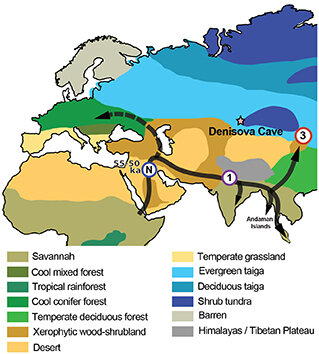I'm still left wondering whether the others really died out and became extinct or were just absorbed. However I guess the geneticists can tell the difference from the traces. ie. if we had equal percentages of each other groups genes then absorption would seem the most likely scenario but as, or so I believe, all the other group's genes are pretty small percentages. I guess that indicates only a small amount of interbreeding and the rest just dying out. Out-competed I suppose.
This is just off-the-cuff so I may be wrong, but I seem to remember reading that the relationship between Neanderthals and Homo Sapiens was a bit more like that between donkeys and horses. So yes they could both procreate with each other and all combinations could produce offspring, but only Neanderthal males and Sapien females produced a fertile offspring. The other way round made an infertile 'mule'. (Or it might be the other way around). So I think there was that dynamic in any interaction. I think also there is evidence that Neanderthal fertility rates were lower anyway, so even if both groups kept each other at a distance, Sapiens would out-breed them over time. So even if it was all very friendly and peaceful, given that there would be huge numbers of modern humans at some point, and the fertility interaction between both species, the incoming humans would then easily swamp and absorb the Neanderthals.
What was the estimated percentage of Neanderthal DNA in Europeans? 4-5%?
So out-competed, yes. I think in the sense that it seems from the archeological record there was just much less innovation in Neanderthal tools and tech, and in the types of hunting/food opportunities they seem to have taken. (From tools and camp sites). We sapiens were able to exploit a lot more food sources and therefore survive in places that Neanderthals would never have thought of going. One must also remember that the Neanderthal is adapted to cold conditions. As the ice age receded they would, like a great many other animals more at home for those periods, at some disadvantage.
Again I may have misremembered, but I do believe there must have been some cultural interaction, as it appears there was a change in Neanderthal tool construction and artefacts in certain places and times, when we were either coming into an area or going through some innovation ourselves. But there seemed to be a limit on the type of things that were 'adopted' by Neanderthals, meaning either they didn't want them - or even they didn't understand what these new guys were doing - which is part of the suggestion in the book
The Mind in the Cave, that Neanderthal minds and therefore their consciousness was actually quite different from our own. (Well, I say
our. I'm European, so I assume I must have a bit of Neanderthal DNA in me somewhere. But you know what I mean!

)

 phys.org
phys.org



